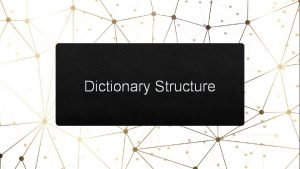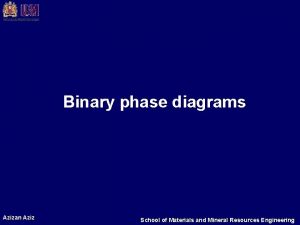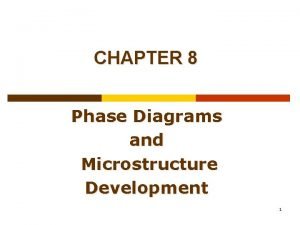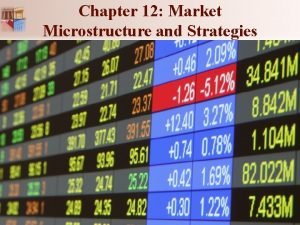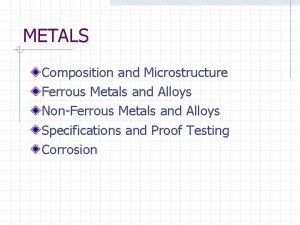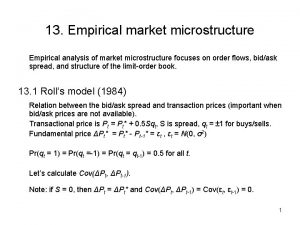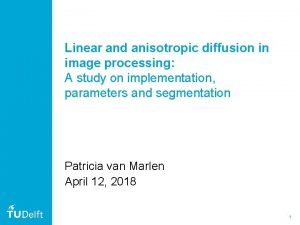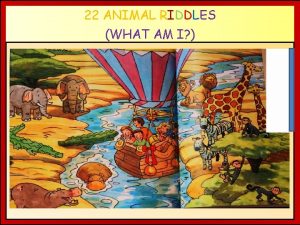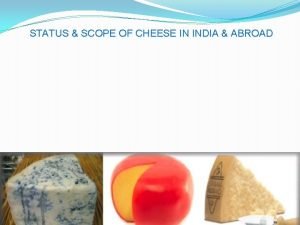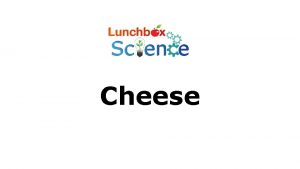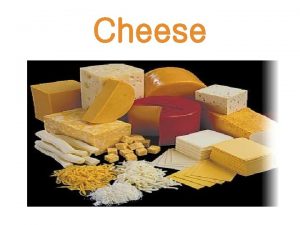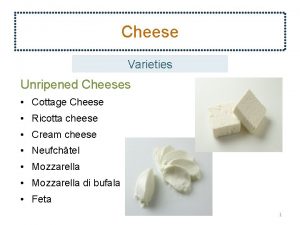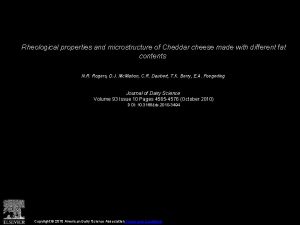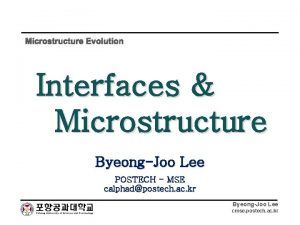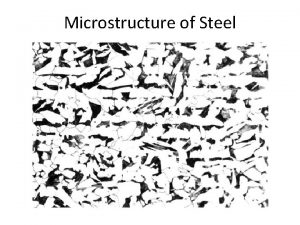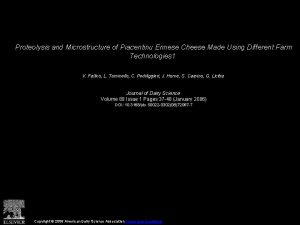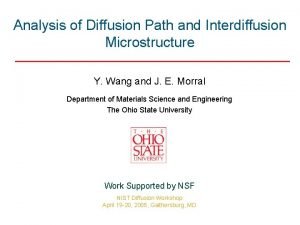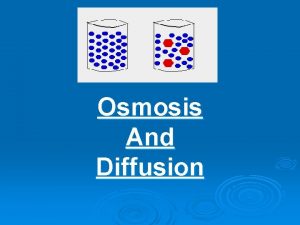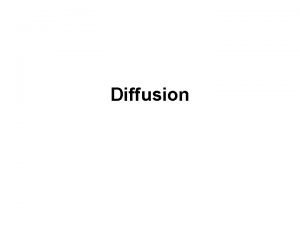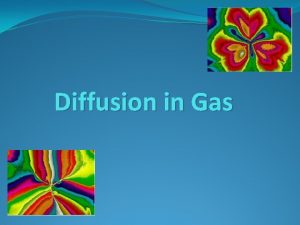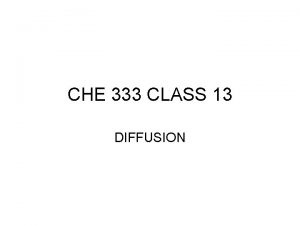Image analysis of cheese microstructure and diffusion properties















- Slides: 15

“Image analysis of cheese microstructure and diffusion properties of solutes: An important link to understand cheese ripening mechanisms” Juliana VALLE COSTA SILVA 1, Chantal CAUTY 1, David LEGLAND 2, Sylvie LORTAL 1, Juliane FLOURY 1, 3 1 INRA, Science and Technology of Milk and Eggs, Rennes, France UMR 782, Food Process Engineering and Microbiology, Thiverval-Grignon, France 3 Agrocampus-Ouest, UMR 1253, Science and Technology of Milk and Eggs, Rennes, France 2 INRA,

2 Context Cheese ripening… - Key step of cheese making technology - Complex and specific of each variety of cheese Substrates Immobilized colonies • Lactose • Proteins • Fat Products • Sugars • Peptides and amino acids • Fatty acids Diffusion phenomena of solutes in cheese • Microbial and enzyme activities • Development of flavor and texture Substrates Products Final quality of cheese Cheese

3 Objective Im ag ea na lys is Diffusion phenomena of solutes in cheese Structure/ composition Structure Diffusion properties Physicochemical characteristics of solutes Composition To enable a better understanding of the ripening mechanisms…

4 Strategy How can you understand control the ripening mechanisms of… Different cheeses… Of different microstructures… With different and complex steps of production and development… Model cheese Homogeneous and reproducible Cheese model

5 Materials and Methods UF-model cheese manufacture Skim milk UF milk ultrafiltrate UF milk retentate Heat treatment (93°C for 15 min) Melting ice for 3 min Heat-treated retentate Sodium azide (0. 05% wt/wt) Coagulant agent (0. 03% v/v) Coagulation at 30°C (1 h) Incubation at 19°C (2 h) UF-model cheese Microfiltration (0. 8 μm) Ultrafiltration (8 k. D) (aqueous phase)

6 Materials and Methods Diffusion of solutes through the UF-model cheese and in the ultrafiltrate using the FRAP technique Prebleach Fluorescent molecule Bleach Recovery Bleached molecule Fluorescent solutes: FITC-dextrans (4 k. Da to 2 MDa) - Flexible and neutral solutes FITC-labeled dairy proteins (α-LA, β-LG and BSA) - Rigid and negatively charged solutes Typical recovery curve of fluorescence in function of time Deff: effectif diffusion coefficient in the UF-model cheese (μm 2/s) Daq: diffusion coefficient in the aqueous phase (ultrafiltrate) w. M: profile width in the radial direction (m) τD: characteristic time of diffusion

7 Materials and Methods Study of the microstructure of the UF-model cheese using TEM Freeze-substitution and low-temperature embedding protocol: - Protects the structure of dairy constituents Cryo-fixation High-pressure freezing: - Samples are frozen in liquid nitrogen (-196°C) at high-pressure (2100 bars) - Advantage: at 2 100 bars the melting point of water decreases because the water becomes 1 500 times more viscous. The increase in viscosity reduces the ice crystal growth rate. Leica EM PACT Freeze-substitution - The sample is immersed in a solvent - Substitution of ice by the solvent Leica EM AFS 2 Embedding Sectioning The solvent is replaced with a low-temperature resin: • Ethanol 3: 1 resin • Ethanol 1: 3 resin • 100% resin Thin sections (90 nm thick) of embedded material are cut with a diamond knife using a Reichert ultramicrotome

8 Materials and Methods Quantitative analysis of the microstructure of the UF-Model Cheese Image pre-processing - Remove noise Mean filter Segmentation - Thresholding Most critical step; care must be taken The image is processed to mark relevant features Quantification of relevant features Porosity → Reduction of the available volume Tortuosity (τ) → Increase of the path length Protein aggregate Shortest path containing a point x in the matrix, connecting two opposite edges of the image (Delarue et al. , 2003).

9 Results and Discussion Influence of different physicochemical characteristics of solutes on diffusion in the UF-model cheese Ø Influence of the solute size… FITC-dextrans (4 k. Da to 2 MDa) - Flexible and neutral solutes Figure 1. Logarithmic plots of experimental diffusion coefficients of FITC-dextrans in the UF-model cheese ( ) and in the ultrafiltrate (� ) as a function of their molecular weight. • The larger FITC-dextrans were no more hindered by the structure of the UF-model cheese when compared to the smaller ones. • The mobility of FITC-dextrans in the UF-model cheese was reduced by a constant obstruction factor (k = 0. 42). • The pore sizes of this model cheese were believed to be sufficiently large when compared to the size of the solute molecules.

10 Results and Discussion Influence of different physicochemical characteristics of solutes on diffusion in the UF-model cheese Ø Influence of the shape and charge of solutes… Rigid and negatively charged solutes were hindered more than the flexible and neutral solutes in the UF-model cheese FITC-labeled dairy proteins (α-LA, β-LG and BSA) - Rigid and negatively charged solutes - - - • The existence of steric and electrostatic interactions between the protein matrix of the UF-model cheese and the FITC-dairy proteins is suggested. • The diffusion through the protein aggregates could play an important role in the overall diffusion of the FITC-dairy proteins, retarding their movement when they diffuse in the UFmodel cheese. -LA -LG BSA Figure 2. Logarithmic plots of experimental diffusion coefficients of FITC-dextrans ( ) and FITC-dairy proteins (� ) in the UF-model cheese as a function of their hydrodynamic radius.

11 Results and Discussion Influence of the microstructure of the UF-model cheese on diffusion of solutes Ø Image Analysis of the UF-model cheese TEM micrograph of the UF-model cheese Segmented (binary) image of the UF-model cheese Quantification of relevant features…

12 Results and Discussion Influence of the microstructure of the UF-model cheese on diffusion of solutes Ø Image Analysis of the UF-model cheese Tortuosity (τ) Porosity (ε) Protein aggregate Tortuosity distribution in the UF-model cheese. Blue zones: low tortuosity. Yellow/orange zones: high tortuosity ε = 0. 638 ± 0. 007 τ = 1. 085 ± 0. 008 Under way… To establish the relationship between these microstructural parameters and diffusion properties by comparing results obtained in model matrices with different microstructures.

13 Conclusions and Perspectives v The physicochemical characteristics of solutes influence their diffusion in the UF-model cheese v The diffusion of other solutes (flexible and negatively charged, rigid or flexible positively charged) may be studied to elucidate the solute-matrix interactions - - + + + + v Studies of the diffusion and structure in other model cheese matrices are required to the development of predictive models of diffusion of solutes v A better understanding of the influence of the matrix microstructure on the diffusion of solutes should allow a more generic view of cheese ripening kinetics for future innovations +

14 Acknowledgements My research team (MICRO): • • • Juliane Floury Sylvie Lortal Anne-Thierry Sophie Jeanson Valérie Gagnaire Chantal Cauty • Platform MRic • David Legland

Thank you for your attention! Juliana. Valle. Costa. Silva@rennes. inra. fr
 What is macrostructure
What is macrostructure Eutectic and eutectoid reaction
Eutectic and eutectoid reaction Development of microstructure in isomorphous alloys
Development of microstructure in isomorphous alloys Market microstructure trading strategies
Market microstructure trading strategies Microstructure of ferrous metals
Microstructure of ferrous metals High frequency market microstructure
High frequency market microstructure Roll's model bid ask spread
Roll's model bid ask spread Does osmosis require energy
Does osmosis require energy What is expansion diffusion
What is expansion diffusion Anisotropic diffusion in image processing
Anisotropic diffusion in image processing Extensive and intensive properties
Extensive and intensive properties Chemical properties of citric acid
Chemical properties of citric acid Analog image and digital image
Analog image and digital image Cheese and onion triangles
Cheese and onion triangles Animal riddles who am i
Animal riddles who am i Site:slidetodoc.com
Site:slidetodoc.com
